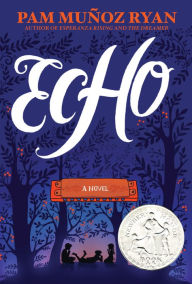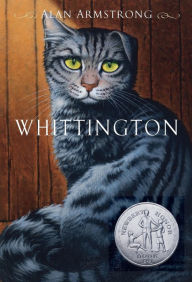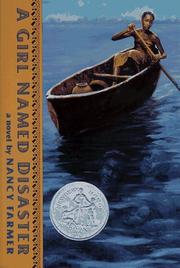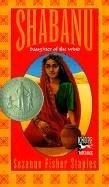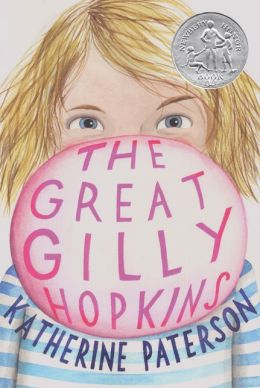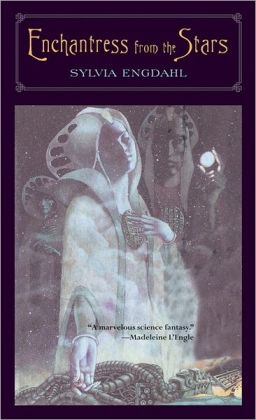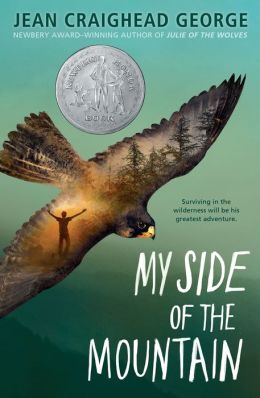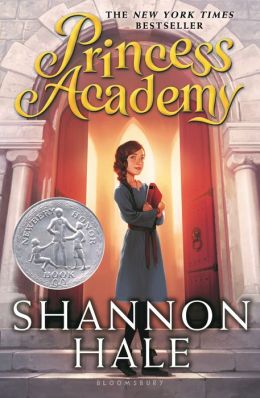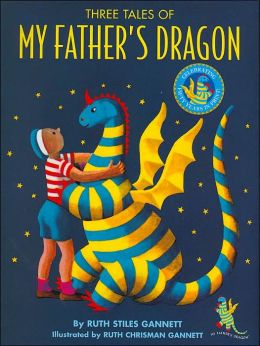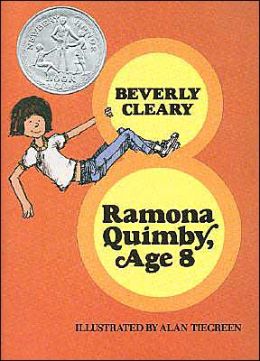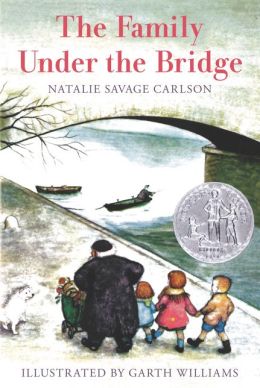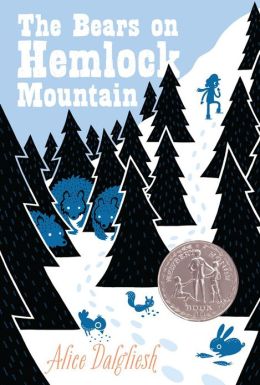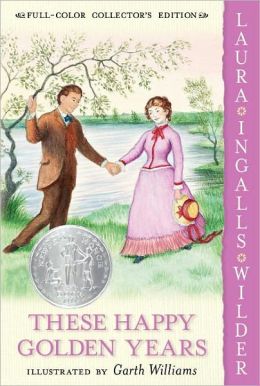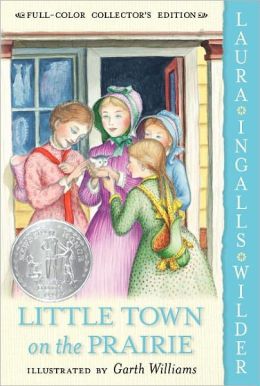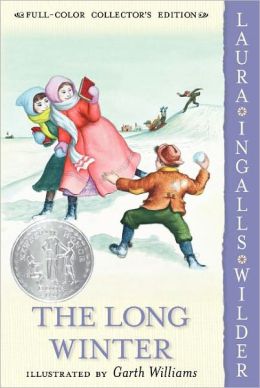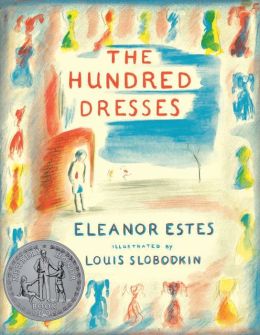new posts in all blogs
Viewing: Blog Posts Tagged with: Newbery Honor, Most Recent at Top [Help]
Results 1 - 25 of 42
How to use this Page
You are viewing the most recent posts tagged with the words: Newbery Honor in the JacketFlap blog reader. What is a tag? Think of a tag as a keyword or category label. Tags can both help you find posts on JacketFlap.com as well as provide an easy way for you to "remember" and classify posts for later recall. Try adding a tag yourself by clicking "Add a tag" below a post's header. Scroll down through the list of Recent Posts in the left column and click on a post title that sounds interesting. You can view all posts from a specific blog by clicking the Blog name in the right column, or you can click a 'More Posts from this Blog' link in any individual post.

By:
Becky Laney,
on 2/15/2016
Blog:
Becky's Book Reviews
(
Login to Add to MyJacketFlap)
JacketFlap tags:
J Fiction,
J Fantasy,
Scholastic,
Newbery Honor,
MG Fiction,
library book,
MG Fantasy,
mg historical,
j historical,
2015,
books reviewed in 2016,
Add a tag
Echo. Pam Munoz Ryan. 2015. Scholastic. 592 pages. [Source: Library]
Did I enjoy reading Echo by Pam Muñoz Ryan? Yes. I found it both unique and compelling. Echo is unique in that it has three-in-one feel to it. Essentially Echo being three middle-grade novels in one. The three are held together by a fairy-tale-esque frame of a story, and, also a physical object: an harmonica. The framework of the story would lead me to think of it as "fantasy" or magical realism. But without that framework--which consists of just a few pages at the beginning and the end--the book IS historical fiction. Nothing happens within the three stories that couldn't--wouldn't--happen in the real world.
The book has three main characters. Friedrich living in Nazi Germany in the early 1930s; Mike living in Pennsylvania in the mid-1930s; Ivy living in California in the early 1940s. Music is a big part of each story, and, each have played the same harmonica.
So which story did I find most compelling? That's not a fair question at all! Friedrich perhaps would be my answer. He is very gifted, but, also publicly and privately shamed because of a birthmark and the fact that he had had epilepsy as a baby/toddler. His "imperfections" may prove too costly for him and his family with Hitler now in control. That and the fact that his father--a musician--is friendly with Jews. Is he "different"? Yes. But in a good way--a BRILLIANT way. When he hears a piece of music, he really HEARS it and REMEMBERS it. And he can play and replay it in his mind, it can "continue" to sweep him away each time. And the fact that he likes to pretend to conduct the music he hears in his head, well, that makes him horribly odd to outsiders. A handful of adults really see him as something special, but, others see him as an embarrassment, a disgrace, a mistake. This story had a few heartbreaking scenes in it. Scenes with the sister, Elizabeth, for example.
The other two stories are set in America. Mike's story features him and his little brother--both orphans. Both are musically gifted which proves to be fortunate. For a wealthy woman has to adopt a musical boy into her family in order to inherit her father's money. The problem? She doesn't *want* to be reminded of heartbreak in her own past. Can Mike and Frankie thaw her heart? Ivy's story is definitely centered on World War II. Her story is slightly more complex than the other two to summarize clearly. Essentially, Ivy (and her family) are Hispanic. They have moved a LOT through Ivy's young life. But the father receives an once-in-a-lifetime opportunity. If he will manage a piece of property for another family--a Japanese-American family being forced to resettle in an internment camp--then he will be hired on as manager or kept on as manager after the war and receive a small bit of property/house. The family experiences some prejudice after the move. Ivy can't attend school with white children. But she can participate in after school activities at the main school--including orchestra.
Overall, this one worked for me. Perhaps some scenes are better--stronger--than others. It is a long novel for middle-graders. As I said, it's like three-in-one! But I essentially enjoyed it
© 2016 Becky Laney of
Becky's Book Reviews
Roller Girl. Victoria Jamieson. 2015. 240 pages. [Source: Library]
Do I typically read graphic novels? Not really. I want to admit that from the very beginning of this review! I might average about two or three a year. And I usually just read the ones that are getting Newbery buzz or actually do get a Newbery or Newbery Honor. Roller Girl IS a graphic novel. It IS a Newbery Honor book for 2016.
Roller Girl is a coming-of-age graphic novel set mainly in the summer as the heroine, Astrid, goes to Roller Derby summer camp. Astrid is a bit angsty that her friend, Nicole, is no longer her best-best friend who wants to do every little thing with her. For example, Nicole does NOT want to go to roller derby camp, she wants to go to dance camp. She also wants to start hanging out with and dating boys. Astrid? Not really her thing--at least not yet. There is some jealousy mixed in with frustration. It isn't just that Nicole is interested in different hobbies. It is that Nicole is spending time--a lot of time--with other people. And one of those people she's now spending a LOT of time with is her nemesis, Rachel. Rachel and Astrid have some ancient history--way back in second grade, I believe?!
Astrid is confused and frustrated and moody and angry and DETERMINED. Roller derby is, by far, the hardest thing she's ever done--ever attempted. And it does not come easy. She is not a natural on skates--not by any stretch of the imagination. And it is physically, emotionally, mentally challenging to her. She WANTS it so bad that she pushes, pushes, pushes to improve. It is because she struggles that I believe she is so relatable.
I also liked how Astrid begins to make other friends outside of Nicole, and, that she is given the opportunity to find her own thing, to become her own person. True, part of that journey involves dyeing her hair BLUE. But having blue hair isn't the "worst" of her crimes--in the eyes of her mom. It is the fact that Astrid is less than honest. Still, I think the two are depicted as having a mostly-positive relationship. Which is nice to see in fiction. That Moms and daughters can get along and talk through their differences.
Astrid also finds a mentor--of sorts--in Rainbow Bite. Readers do learn a good bit about the sport of Roller Derby.
So overall, I enjoyed the characterization. I enjoyed the coming-of-age aspect of it. And despite the fact that it is a graphic novel, and, despite the fact that it is sports-focused, I did enjoy it. I read it quickly, in one setting.
© 2016 Becky Laney of
Becky's Book Reviews
26 Fairmount Avenue. Tomie dePaola. 1999. Penguin. 80 pages. [Source: Library]
Did I enjoy reading Tomie dePaola's 26 Fairmount Avenue? Yes. I think I appreciated it more upon rereading than I did the first time I read it a decade ago. This autobiographical early chapter book is about his moving to 26 Fairmount Avenue. It is not a simple transition, or, an easy move. Because life happens, things--big things, little things--keep happening to prevent work on the new house and to prevent their move. This building of the new house is always in the background. Meanwhile, he's growing up and having plenty of firsts. One of the incidents in the book is of his going to see Snow White at the theatre with his family. It captures what he thought as he saw the story unfold on screen. The intensity of it--how mesmerizing it was. And yet, HOW UNLIKE THE BOOK. So he is both drawn to it and repulsed by it. Finding it amazing and magical, and yet feeling it was missing something. This resonated with me. I liked the flow of the narrative. It has a comfy-cozy feel to it.
I don't think I've read the others in this series. I may need to seek them out soon.
© 2015 Becky Laney of
Becky's Book Reviews

By:
Becky Laney,
on 9/13/2015
Blog:
Becky's Book Reviews
(
Login to Add to MyJacketFlap)
JacketFlap tags:
Animal fantasy,
MG Fiction,
library book,
MG Fantasy,
books reviewed in 2015,
Random House,
J Fiction,
J Fantasy,
Newbery Honor,
2005,
Add a tag
Whittington. Alan Armstrong. 2005. Random House. 208 pages. [Source: Library]
I enjoyed reading Alan Armstrong's Whittington. This book celebrates two of my favorite things: storytelling and cats. The framework of the story really worked for me. The modern day story is of a cat, Whittington, and his friends living in a barn. The book tells of his arrival at the barn, his meeting of the other animals, their hesitant acceptance of him. Soon Whittington proves his worth. One reason why may be he is great at storytelling. He tells the story of Dick Whittington and His Cat to the others. So readers are treated to TWO equally delightful stories. The book also features a few children, a brother and sister, the young boy is having trouble learning to read. The book explores the concept of the Reading Recovery program.
I liked this one very much. I liked all of the stories. I liked the characters--human and animal. It was just a satisfying way to spend an afternoon.
© 2015 Becky Laney of
Becky's Book Reviews
A Girl Named Disaster. Nancy Farmer. 1996. Scholastic. 320 pages. [Source: Review copy]
I read A Girl Named Disaster and Shabanu: Daughter of the Wind the same week. That fact definitely influenced my thoughts on both books--fair or not. Reading is subjective, after all.
Did I enjoy reading A Girl Named Disaster? Yes and no. I didn't exactly "enjoy" it. I found it a bit slow at the beginning, and, a bit rushed at the end. There were times I definitely found it interesting, but, I never really found myself loving it.
Nancy Farmer's A Girl Named Disaster is set in Mozambique and Zimbabwe in the early 1980s. Nhamo has an interesting relationship to the rest of the family. She dearly, dearly loves her grandmother (Ambuya), and is in return beloved of her grandmother. (She is in fact probably the favorite granddaughter.) But the rest of her family is a different story. They seem to blame Nhamo for the circumstances of her birth. Her mother returned home from school (high school??? college???) pregnant and married to a "useless" man, a man named Proud. Neither is in her life when the novel opens. Her mother died when Nhamo was a toddler--eaten by a leopard. Her father had disappeared even before that. Nhamo is, without a doubt, a hard worker. Yes, she is slightly bitter that her tasks are more difficult and time-consuming than her slightly-older cousin's--Masvita. But she isn't hate-filled and overflowing with attitude either.
Like Shabanu, A Girl Named Disaster introduces readers to a culture where marriage happens VERY early in life for girls--twelve to fourteen, and where a woman's worth is very much tied to her ability to produce children, particularly sons. Like Shabanu, A Girl Named Disaster features a heroine who is to be sacrificed via marriage. Like Shabanu, this marriage is MOST, MOST unwelcome. Dare I say this would-be marriage sounds even more unpleasant than the one in Shabanu--and I never thought I'd say that. Like Shabanu, the heroine makes the only choice she can under the circumstances....
Nhamo runs away from home in an attempt to make it across the border to Zimbabwe. Once there, she'll pretend to be Catholic--her mother attended a Catholic school--and seek refuge with nuns. Is she actually Catholic? No. Of course not. Her ideas of who Jesus is are far from sound, to say the least. But that is not exactly the point of A Girl Named Disaster.
Her journey to Zimbabwe is....much longer than she imagined it ever could be. It is not a journey of a few days or even a few weeks. MONTHS go by with Nhamo still struggling to reach her destination. It is her fight for SURVIVAL. It is definitely nature versus Nhamo...with Nhamo receiving a bit of help from the spiritual world.
Will Nhamo's life be better--easier--in Zimbabwe? Will she find her father? Will she find her father's family? Will she find welcome with them? What will happen to her if she doesn't find them? What will become of her? What are her chances of a decent life, a good life???
A Girl Named Disaster is slightly less depressing than Shabanu. That's not fair. It's not. The ending sees Nhamo with a bit of hope and a chance at a future.
Still neither book "feels" like a children's book. And when I do think of Newbery or Newbery Honor, I tend to think CHILDREN'S BOOK more than anything else. Arranged marriages, child-adult marriages, don't really come to mind. Still exposure to diverse titles can be a good thing. And both books offer readers something to think about.
© 2015 Becky Laney of
Becky's Book Reviews
Shabanu: Daughter of the Wind. Suzanne Fisher Staples. 1989. 240 pages. [Source: Book I Bought]
Did I enjoy reading Shabanu: Daughter of the Wind? Not really. This Newbery Honor book doesn't fit my idea of what a Newbery or Newbery Honor book should be. I'm not sure that's fair on my part, and it could be a good thing to be a shockingly different children's book.
Shabanu is the young heroine of the novel. She's eleven or perhaps twelve. On the verge of "adulthood" in her culture, she's almost of marriageable age. Her wedding has already been arranged--a cousin--but it is about one year away still. Her sister's wedding, her sister is about thirteen, is months away when the novel opens. The arranged marriages for both of them are with their cousins. (I think one is 15, one 17. They are brothers). The novel is set in Pakistan. (I'm assuming contemporary-to-the-publication Pakistan). Shabanu and her family live in the desert, and live a more nomadic lifestyle. They travel from place to place depending on the time of year and the amount of water. Shabanu loves, loves, loves, LOVES tending the camels, and, she has definite favorites among them. She does not envy her sister being "all grown up." She enjoys the freedom she has as a child. Though it's not complete, absolute freedom ever. (I'm not saying it should be necessarily.)
The setting is interesting. Readers definitely get exposed to a whole new world, a camel-centric world. I thought there were at times a little too much information about the camels. (Warning: there's CAMEL SMUT)
If life had gone according to plan, the novel would not have taken a decidedly dark and depressing turn. But things went horribly wrong before her sister's wedding, and, Shabanu herself pays the price though she is not responsible or to blame for the souring of events. It seems most all the characters have a happier end than she herself does. That may or may not be completely realistic, but, it certainly isn't fair. It may push the extremes of what children consider NOT FAIR.
I'm not sure what response readers are to have with a novel like this. Shabanu may be the first or one of the first books readers come across that either a) stars a Muslim family, features a Muslim heroine, OR b) is set in Pakistan. I doubt the impression of either will be a good one, if that makes sense. Especially considering the ending.
© 2015 Becky Laney of
Becky's Book Reviews
On My Honor. Marion Dane Bauer. 1986. Houghton Mifflin Harcourt. 96 pages. [Source: Review copy]
The good news is that the jacket copy of this book is so straight forward I would have known to avoid this one as a kid. (Sad books and I did
not get along.)
What is the book about? Joel and Tony are close friends, perhaps even best, best friends. But Joel isn't honest with Tony. And Tony isn't honest with Joel. If either boy had been honest, then the book wouldn't exist essentially. The truth is, Joel doesn't want to go with Tony to Starved Rock state park to climb the bluffs. And Tony doesn't want to go swimming at the city pool with Joel. Joel's last hope is that his Dad will say no to the boys biking over to the state park. Is Joel honest with his Dad? Of course not! Don't be silly. His Dad thinks his son wants to go biking with his friend. And though he knows it may be beyond his child's ability to bike eight or nine miles each way, he says yes. Perhaps he wants his son to like him and think he's cool? Joel tries to hide his disappointment that his Dad failed him by setting up good boundaries, and reluctantly Joel sets off on a very long journey. (In the Dad's defense, Joel and Tony are not honest about what they're going to do once they get to the state park.)
At some point, perhaps halfway, perhaps not. The boys take a break on the bridge. Tony decides to change plans. Now Joel had promised his Dad that they wouldn't change plans, that they would go where they were supposed to go, and do what they were supposed to do, but, does Joel have the integrity, the "honor," to stand his ground? Of course not! Not in this book! Tony decides to go swimming in the river, the river that both boys had been warned was dangerous dozens and dozens of times. Tony talks his friend into going swimming in a dangerous river. Joel knew he was making a bad decision, a "wrong" decision, a breaking-all-rules, and going-against-my-parents-decision, but he goes along with Tony anyway. Into the water they go. But Tony has a big secret: he can't swim. And, as you can imagine, swimming in a dangerous river with strong currents and whirlpools is not the best idea if you can't swim. So Tony drowns.
What little regard I have for Joel is completely lost in the next half of this oh-so-short novel. (I was so thankful this one is short!!!) Is Joel honest with anyone after the accident? Does he tell the police? Does he tell Tony's mom? Does he tell his Dad? It's not that he doesn't tell anyone--he tells a stranger, someone near the scene that he gets to look for Tony in the river--but when this stranger wants to do the right thing, the only necessary thing, Joel makes promises he has no intention of keeping. The lying begins. He has no idea what happened to Tony. He left Tony on the road, on his way to the state park. Tony was alive and biking the last time he saw him. He has no idea why he isn't back home yet.
The truth does come out, of course, but not in a way that puts Joel in a good light, an honorable position. The book ends with Joel and his Dad having a heartfelt conversation. But that conversation didn't sit right with me. Joel wants assurance that there is a heaven and that his friend, Tony, is there. And his Dad tells him that no one can be sure that there even is a heaven. But if there is a heaven, then he's sure Tony is there. I'm not sure which annoys me more. The emphasis that "no one can be sure" there is a heaven, or, the assumption that anyone who dies automatically goes to heaven. I'm not suggesting that the book should end with a discussion that heaven is a real place and hell is a real place, and unless you're trusting in Christ as your Savior, you're destined for hell. That's an unlikely book ending for sure.
Who's responsible? Who's to be held accountable? Who's to blame? The book spends some time devoted to this, mostly through showing and not telling. (Though that last conversation with his Dad does bring this up.) The book certainly can bring a reaction out of the reader.
On My Honor was a Newbery Honor book in 1987.
© 2015 Becky Laney of
Becky's Book Reviews

By:
Becky Laney,
on 7/24/2015
Blog:
Becky's Book Reviews
(
Login to Add to MyJacketFlap)
JacketFlap tags:
J Fiction,
Survival,
Newbery Honor,
J Realistic Fiction,
1986,
MG Fiction,
library book,
MG Realistic Fiction,
books reviewed in 2015,
Add a tag
Hatchet. Gary Paulsen. 1986. Simon & Schuster. 208 pages. [Source: Library]
I still can't say that I love this cover of Hatchet, but, avoiding the book because of the cover was a bit silly of me. So did I enjoy reading Hatchet? Yes, for the most part. Hatchet is a survivor story starring Brian Robeson. (It is a Newbery Honor book). Brian is on the way to visit his Dad after the dramatic divorce. (Brian knows something his father doesn't. This SECRET haunts him throughout the book. He's definitely not over the divorce.) But the single engine plane taking him to visit his Dad never arrives. The pilot has a heart attack, and Brian must land/crash the plane himself. He survives the crash, but will he know how to survive in the wild until he is rescued? Fortunately, his mom gave him a hatchet before the trip. And it's a hatchet he wore on the plane, on his belt, I believe? So it's the one thing he has with him that may enable him to survive until help comes...
Brian has adventures and misadventures. He manages to survive, but, never to the point where it becomes fun and amazing. These aren't adventures he'd ever choose to have.
I definitely am glad I read this one. Have you read it? What did you think?
© 2015 Becky Laney of
Becky's Book Reviews

By:
Becky Laney,
on 6/26/2015
Blog:
Becky's Book Reviews
(
Login to Add to MyJacketFlap)
JacketFlap tags:
J Fiction,
Newbery Honor,
J Realistic Fiction,
1978,
children's classic,
MG Fiction,
book I bought,
MG Realistic Fiction,
books reviewed in 2015,
Add a tag
The Great Gilly Hopkins. Katherine Paterson. 1978. 256 pages. [Source: Bought]
"Gilly," said Miss Ellis with a shake of her long blonde hair toward the passenger in the back seat. "I need to feel that you are willing to make some effort."
Galadriel Hopkins is the narrator of The Great Gilly Hopkins. What's she like? Angry, sarcastic, bitter, reluctant to make connections. Gilly is a foster kid. She's been in plenty of different foster homes for most of her life. Some slightly better than others. But none of them ever feeling like a real home. To tell the truth, Gilly wouldn't know what to do in a foster home that feels like HOME. For Gilly is clinging tightly to the dream that her mom will come back for her, that her mom loves her very much and actually misses her. When the novel opens, Gilly is getting placed in a new home...
Mrs. Trotter is her new foster mother. She also has another foster kid, William Ernest, in her home. From the very start, I thought Mrs. Trotter was a great character. And I also loved Mr. Randolph, the blind neighbor that comes to the Trotters' house for meals. These two adults were so lovable in comparison to the not-so-lovable Gilly. And the love they show to Gilly is
something. I was reminded of hesed love.
"Hesed is one-way love. Love without an exit strategy. When you love with hesed love, you bind yourself to the object of your love, no matter what the response is... Hesed is a stubborn love" ~ Paul Miller, A Loving Life: In A World of Broken Relationships, 24.
Did I love The Great Gilly Hopkins? Not exactly. I liked it. I appreciated it. But I didn't love it.
© 2015 Becky Laney of
Becky's Book Reviews
Enchantress from the Stars. Sylvia Louise Engdahl. 1970/2003. Penguin. 304 pages. [Source: Review copy]
From the prologue:
The planet shines below us, cloud-flecked, dazzling against the dark backdrop of space. Down there it is cool and green and peaceful. In a little while we will take the ship out of orbit and leave this world behind, a mere speck in the vast currents of the universe. This world, which we call Andrecia--the third planet of a quite ordinary yellow sun...but that's just coincidence, of course. What difference does it make that just such a planet was my own people's ancestral home?From chapter one:
At the edge of the Enchanted Forest there lived a poor woodcutter who had four sons, the youngest of whom was named Georyn. They were able to earn a meager living by selling wood to the folk of the village, and although there was seldom more than dry bread or thin gruel on their table, they were not miserable. I'm so glad I decided to reread Sylvia Engdahl's Enchantress from the Stars for my Newbery reading challenge. (It was a Newbery Honor book in 1971). I loved, loved, loved it the first time I read it. I loved it just as much the second time. (I love it when a book rereads well. Not all books do. That's one way you can distinguish between a good book and a great book.) I would definitely say it's a premise-driven book, but, that being said there is plenty of action and plenty of characterization. So it has many strengths.
Enchantress from the Stars is narrated, primarily, by a young woman named Elana. The novel is reflective, in a way, because the novel is an account of her first 'adventure' on another planet. She's writing her report, giving her side of the story. But this novel is more than just her side of the story. It ventures to include the perspectives of two others--a young man, the woodcutter's youngest son, Georyn, and a young medical officer named Jarel. Both Georyn and Jarel are from Youngling cultures. Georyn is a native to Andrecia; Jarel is from another planet, a planet in a different stage than Georyn's, but a great deal less advanced than Elana's. (He is with the Imperial Exploration Corps). Jarel is just one of many in the first ship sent to "colonize" this planet.
Elana is on a ship with several other agents--including her father--when they learn that Andrecia is being invaded, and a Youngling culture/civilization is being threatened. They can't directly intervene. And they definitely can't reveal themselves. But they can try to influence things subtly, indirectly. Elana is chosen--with some reluctance--to interact with the natives. Well, she's to interact with two brothers--Terwyn and Georyn. These two are on a quest--along with their older brothers--to KILL A DRAGON. Yes, they are on their way to get the king's blessing, the king's permission to enter the Enchanted Forest. They don't know what dangers they'll face, but they know the fiery dragon must be stopped. These brothers see Elana an an enchantress, a faery perhaps. They see her as having great power, great wisdom, great magic.
So Enchantress from the Stars reads as a fantasy novel--a fantasy novel in the style of a fairy tale. But. Of course it also reads as a great science fiction novel with space ships, etc.
What did I love about this one? Everything! I loved the premise. Just loved it! I loved the world-building, the setting, the atmosphere. I loved the storytelling. I loved the characterization!!! I loved Elana. I loved Georyn. I loved Jarel. I even cared a great deal about the Starwatcher and Evrek. I thought this book was just so well written. © 2015 Becky Laney of
Becky's Book Reviews

By:
Becky Laney,
on 6/10/2015
Blog:
Becky's Book Reviews
(
Login to Add to MyJacketFlap)
JacketFlap tags:
Nonfiction,
Holocaust,
autobiography,
World War II,
Newbery Honor,
YA nonfiction,
children's classic,
mg nonfiction,
library book,
1972,
Add a tag
The Upstairs Room. Johanna Reiss. 1972. HarperCollins. 208 pages. [Source: Library]
I am so glad I decided to read Johanna Reiss' The Upstairs Room. This one has been on my list of books I needed to read for quite a while--over a decade at least. It is nonfiction--a biography--set during World War II. The author and her sister were Jews that hid for several years from the Nazis.
Readers meet Annie, the young heroine, and her family. She has several older sisters, a mother and father. The war changes everything for the family. The mother, who was close to death anyway--the Nazis invasion of Holland didn't really change the outcome. The family found hiding places, but, separate hiding places. Annie was placed in a hiding place with one of her sisters. Readers meet the two families that hid the two girls. One family became like a second family to her. I found the book to be a quick read, and quite intense.
The book itself was well-written: both compelling and well-paced. What surprised me a little bit, and what might surprise others as well, is the language. I wasn't expecting (strong) profanity in a Newbery Honor book! I really wasn't. That being said, it wasn't a huge issue for me--as an adult reader. But I could see how it might not work for certain families as a read-aloud choice.
© 2015 Becky Laney of
Becky's Book Reviews

By:
Becky Laney,
on 5/29/2015
Blog:
Becky's Book Reviews
(
Login to Add to MyJacketFlap)
JacketFlap tags:
friendship,
J Fiction,
Newbery Honor,
J Mystery,
J Realistic Fiction,
2009,
children's classic,
MG Fiction,
MG Realistic Fiction,
MG Mystery,
books reviewed in 2015,
1967,
Add a tag
The Egypt Game. Zilpha Keatley Snyder. 1967/2009. Simon & Schuster. 215 pages. [Source: Review copy]
Not long ago in a large university town in California, on a street called Orchard Avenue, a strange old man ran a dusty shabby store. Above the dirty show windows a faded peeling sign said: A-Z Antiques Curios Used Merchandise. Part of me wishes I'd read The Egypt Game years ago. I loved, loved, LOVED it. Though part of me still loves the fact that there are still WOW books waiting for me to 'discover' them. I do love being swept away by a great book.
The Egypt Game celebrates friendship and imagination. The Egypt Game was invented by Melanie Ross and April Hall. Soon after they meet--very soon--they discover they are kindred spirits. Both have big imaginations, love storytelling, and have a fascination with Ancient Egypt. The Egypt Game is played in an abandoned lot near their neighborhood. They sneak in through a gap in the fence, I believe. Melanie's younger brother--much younger brother, Marshall--is part of the fun as well. He's four, and, he almost always, always brings his octopus, Security. By the end of the book, there are SIX "Egyptians" playing the Egypt game...
I do love the storytelling and imaginative play. How creative they all are in coming up with ideas for what to act out or play next. But I also love how they build a world and fill it with stuff, with costumes as well. But I also love the mystery element to the novel.
I would definitely recommend this one. I came to love all the characters. And there was a scene that just got to me--it reminded me so much of To Kill A Mockingbird. Anyway, I loved this one, and you may too. If you've read it, I'd love to know what you think of it!
© 2015 Becky Laney of
Becky's Book Reviews
My Side of the Mountain. Jean Craighead George. 1959. 192 pages. [Source: Bought]
I found My Side of the Mountain by Jean Craighead George to be strangely compelling. That is, I wasn't exactly expecting it to so compelling. I don't typically like adventure-survival-living-off-the-land books or becoming-one-with-nature books. It's also written in the first-person something that either really works (for me) or really doesn't.
Sam Gribley is the hero of My Side of the Mountain. He has run away from his oh-so-crowded home. He has traveled to the Catskill Mountain wilderness. He's heard his father talk about one of his ancestors having a homestead there, a long-abandoned homestead now. He's determined to find "his" land, and live on it, alone in the wilderness. He's read up on the subject. He's confident and determined, more determined than confident, perhaps. It isn't always easy for Sam. Though sometimes things do happen to go his way. The book spans about a year. In that year, plenty happens though not all of it will prove exciting to every reader. I was surprised by how many people he met and how many friends he made.
I think what I found most compelling about this one was the narrative voice. I don't think I was swept up into the adventure so much as I found myself liking Sam.
Have you read My Side of the Mountain? I'd love to hear what you thought of it!
© 2015 Becky Laney of
Becky's Book Reviews

By:
Becky Laney,
on 5/14/2015
Blog:
Becky's Book Reviews
(
Login to Add to MyJacketFlap)
JacketFlap tags:
mg historical,
j historical,
books reviewed in 2015,
J Fiction,
Newbery Honor,
children's classic,
MG Fiction,
1964,
book I bought,
Add a tag
Across Five Aprils. Irene Hunt. 1964. 224 pages. [Source: Bought]
Did I love, love, love Irene Hunt's Across Five Aprils? Probably not. Did I love it a lot more than I thought I would? Yes, definitely. Across Five Aprils is a Newbery Honor Book. This May I'll be focusing on Newbery honor books and winners published in the 1960s. I probably wouldn't have picked this one up if I hadn't been doing a Newbery challenge or two this year. I'm very glad I read this one.
Across Five Aprils is historical fiction. Jethro Creighton is the hero of the novel. It opens in April 1861 and concludes in April 1865, I believe. Readers see the Civil War through his eyes. He is not a soldier, he's just a boy. His older brothers, however, do go to war. (This one is set in Illinois). Most of his brothers fight for the Union, but, one of his brothers, his favorite brother, fights for the Confederacy. Jethro tries to keep up with the war news as well as he can, mainly through newspapers he picks up when he does manage to get into town, but also from letters home from his brothers. Jethro is busy enough on the farm. He's essentially running his family's farm.
Readers get an opportunity not only to get to know Jethro, but his family as well. I was most interested in his sister, Jenny, and his schoolteacher, Shadrach Yale.
There were many things I liked about Across Five Aprils. I thought the characterization was very well done. Some of the scenes were just wonderful.
© 2015 Becky Laney of
Becky's Book Reviews

By:
Becky Laney,
on 5/12/2015
Blog:
Becky's Book Reviews
(
Login to Add to MyJacketFlap)
JacketFlap tags:
J Fiction,
J Fantasy,
Newbery Honor,
2005,
series book,
Bloomsbury USA,
MG Fiction,
library book,
MG Fantasy,
books reviewed in 2015,
books reread in 2015,
Add a tag
Princess Academy. Shannon Hale. 2005. Bloomsbury. 314 pages. [Source: Library]
I enjoyed rereading Shannon Hale's Princess Academy. I wanted to reread both Princess Academy and Palace of Stone before reading the third book out just this year. There isn't always time for me--unfortunately--to reread all the books in a series each time a new book is released, but, I do try to make it a priority when I've loved the author's work in the past. And that is certainly the case with Shannon Hale!
Miri is the heroine of Princess Academy. She is small, for her age, and is, in a way, kept separate from others her own age for the simple fact that everyone but Miri is already working in the quarry. Miri tends the goats and keeps house for her family: her older sister and father. (Her mother died within a week of giving birth to her.) Her father isn't a man of many words, and, Miri misunderstands much. The community in which she lives is dependent on traders. They work the quarry and mine linder, they trade the precious stone for food and other supplies. It is both an anxious and exciting time for the village. This year is especially so. For this year the trader brings a BIG, BIG message. All the girls of the community--within a certain age, I believe twelve or thirteen to sixteen or so--MUST attend Princess Academy. For the prophets have revealed that Mount Eskel is the home of the future Princess/Queen. The prince heir (Steffan) will visit the academy in one year to choose his bride. All the girls must be trained and educated for any one of the girls could potentially be 'the one'. It is a huge shock to the community. Miri, of course, is one of the girls.
Readers get to know many of the girls at the Princess Academy. Some better than others, of course. Britta and Katar are two girls that get much attention. For very different reasons though. The book chronicles Miri's time at the academy: what she's learning, what they're all learning, what she likes, what she wants, etc. One thing she wants is to be able to go home more frequently and see Peder, the boy she loves and hopes one day to marry.
Another focus of the book is on quarry speech and the magical qualities of linder.
The book celebrates stories and storytelling and the power of words and literacy, the importance of education and knowledge. Miri is wise because she is able to absorb what she's taught and use it to her advantage and to the community's advantage.
© 2015 Becky Laney of
Becky's Book Reviews

By:
Becky Laney,
on 5/5/2015
Blog:
Becky's Book Reviews
(
Login to Add to MyJacketFlap)
JacketFlap tags:
series books,
J Fiction,
J Fantasy,
Newbery Honor,
children's classic,
1950,
MG Fiction,
library book,
MG Fantasy,
1948,
1951,
books reviewed in 2015,
Add a tag
Three Tales of My Father's Dragon. Ruth Stiles Gannett. Illustrated by Ruth Chrisman Gannett. 1987. Random House. 242 pages. [Source: Library]
I really enjoyed reading My Father's Dragon (1948), Elmer And the Dragon (1950), and The Dragons of Blueland (1951), all by Ruth Stiles Gannett. (My Father's Dragon was a Newbery Honor book for 1949.) I'd read My Father's Dragon before many years ago--long before I started blogging--but this was my first opportunity, I believe, to read the two sequels.
I loved the way My Father's Dragon opens:
One cold rainy day when my father was a little boy, he met an old alley cat on his street. The cat was very drippy and uncomfortable so my father said, "Wouldn't you like to come home with me?" This surprised the cat--she had never before met anyone who cared about old alley cats--but she said, "I'd be very much obliged if I could sit by a warm furnace, and perhaps have a saucer of milk." "We have a very nice furnace to sit by, said my father, "and I'm sure my mother has an extra saucer of milk." My father and the cat became good friends but my father's mother was very upset about the cat. She hated cats, particularly ugly old alley cats. "Elmer Elevator," she said to my father, "if you think I'm going to give that cat a saucer of milk, you're very wrong. Once you start feeding stray alley cats you might as well expect to feed every stray in town, and I am not going to do it!"
This opening hooked me. It is through the cat--his cat--that he learns of a baby dragon in desperate need of help. He tells of the Island of Tangerina and Wild Island. He learns about the captive dragon and the dangerous residents of the island. He is determined to help free the dragon. The cat helps him form a plan...
The first book is all about his going to the islands, his adventures and misadventures as he's looking for the dragon--it's a good thing he came to the island well-prepared! Does he find the dragon? You can guess the answer to that. Of course he does!
My Father's Dragon is a delightful fantasy book for very young readers. It's short and quite satisfying.
In Elmer and the Dragon, Elmer starts his journey home--by dragon. His new dragon friend will fly him home. But neither Elmer or the dragon know the way home precisely. Elmer ends up having just as many adventures returning home as he did running away from home. One of the stops along the way is Feather Island, the home of all 'lost' canaries.
In The Dragons of Blueland, the dragon sets off to return to his own family that he hasn't seen since his captivity. He's anxious to be reunited. But when he returns, he learns that his own family--his very large family--has been trapped in their cave. The entrance is guarded by men intent on capturing them or perhaps even killing them. He needs to find a way to help his family! So he seeks out Elmer...
All three books are great. It's oh-so-easy to recommend these.
© 2015 Becky Laney of
Becky's Book Reviews

By:
Becky Laney,
on 4/30/2015
Blog:
Becky's Book Reviews
(
Login to Add to MyJacketFlap)
JacketFlap tags:
MG Realistic Fiction,
books reviewed in 2015,
family,
friendship,
Summer,
J Fiction,
Newbery Honor,
J Realistic Fiction,
children's classic,
MG Fiction,
library book,
1957,
Add a tag
Gone Away Lake. Elizabeth Enright. 1957. 256 pages. [Source: Library]
I enjoyed reading Elizabeth Enright's Gone-Away Lake. I am so glad to be participating in the Newbery Through the Decades reading project. I've been motivated to read many books that I probably never would have read.
Gone-Away Lake tells the summertime adventure of two cousins: Portia and Julian. Early on in the summer these two stumble upon a muddy, dried-up lake. They discover a "ghost town" of sorts--the remnants of a lake resort community. To their great surprise, they discover that it is not as abandoned as it first appeared. Two people still live there. A brother and sister. (They live in separate houses.) Her name is Mrs. Cheever. His name is Mr. Payton. The four become friends--good friends. There are thousands of stories to be shared. Much to explore. Much to do.
I enjoyed this one very much. It's not an action-packed story (though it does have an intense scene or two--at least relatively speaking). It's definitely driven by the interesting characters. (Something I can definitely appreciate!)
Have you read Gone-Away Lake? What did you think? How do you think it compares to Thimble Summer?
© 2015 Becky Laney of
Becky's Book Reviews

By:
Becky Laney,
on 4/17/2015
Blog:
Becky's Book Reviews
(
Login to Add to MyJacketFlap)
JacketFlap tags:
series books,
J Fiction,
Newbery Honor,
Beverly Cleary,
J Realistic Fiction,
MG Fiction,
library book,
1981,
MG Realistic Fiction,
books reviewed in 2015,
books reread in 2015,
Add a tag
Ramona Quimby, Age 8. Beverly Cleary. 1981. HarperCollins. 208 pages. [Source: Library]
I really love the Ramona series, and, Ramona Quimby, Age 8 is one of my favorites. Ramona is in third grade in this book. Her father will be working part-time for the market and going to school again so he can be a teacher.
"The First Day of School" Ramona starts third grade, and meets a boy, Danny, she nicknames Yard Ape. Her teacher is Mrs. Whaley, and, like in previous books, it takes Ramona a while to decide if she likes her new teacher, and, if her new teacher actually likes her too. School can be so tricky!
"At Howie's House" Ramona loves Sustained Silent Reading at school, even though she doesn't like calling it D.E.A.R. (Drop Everything And Read). Can she use this trick at the Kemps house after school to avoid playing with Willa Jean? Perhaps. At least some of the time.
"The Hard-Boiled Egg Fad" Ramona regrets following a new fad when her mom grabs an egg from the wrong shelf to send in her lunch. The fad is hard-boiled eggs, and the raw egg makes a horrible mess. Ramona is angry and embarrassed.
"The Quimbys' Quarrel" Ramona and Beezus complain about eating TONGUE. And the parents decide to punish them.
"The Extra-good Sunday" Beezus and Ramona do not get out of their punishment: cooking a meal for the family. What do Ramona and Beezus know how to cook, or to cook well? It will be an experiment for sure.
"Supernuisance" Ramona gets sick at school and throws up in front of the class. She's so embarrassed.
"The Patient" Her mom stays home to take care of her when she's sick. Ramona gets a homework assignment: a book report.
"The Book Report" Ramona has to read The LEFT BEHIND CAT for a book report, but, she doesn't like it. How to make the review entertaining? How about doing her report like a commercial? This is a funny chapter!
"Rainy Sunday" The Quimbys turn a dismal day--everyone's a bit grumpy--around by going to Whopperburger. Ramona orders from the adult menu for the very first time.
© 2015 Becky Laney of
Becky's Book Reviews

By:
Becky Laney,
on 4/12/2015
Blog:
Becky's Book Reviews
(
Login to Add to MyJacketFlap)
JacketFlap tags:
1958,
library book,
books reviewed in 2015,
HarperCollins,
family,
friendship,
J Fiction,
Newbery Honor,
children's classic,
MG Fiction,
Add a tag
The Family Under the Bridge. Natalie Savage Carlson. Illustrated by Garth Williams. 1958/1989. HarperCollins. 123 pages.
Once there was an old hobo named Armand who wouldn't have lived anywhere but in Paris. So that is where he lived. Everything that he owned could be pushed around in an old baby buggy without any hood, so he had no worries about rents or burglars. All the ragged clothing he owned was on his back, so he didn't need to bother with trunks or dry-cleaners. It was easy for him to move from one hidey-hole to another so that is what he was doing one late member in December.Have you read The Family Under the Bridge?! Why did no one tell me how WONDERFUL it was? I read it and absolutely loved it.
The Family Under the Bridge is set in Paris in December. (So it would be perfect to read around Christmas or New Year's Day). Armand is the hero. As he prepares for winter, he makes plans to go and live under "his" bridge. When he arrives, he discovers that there is a family already living there. At first, he thought he would leave immediately and go find another bridge to live under. But. He lets himself be talked into staying. The family includes two little girls and a little boy and their mother.
"It looks to me like you've already found a new place," said Armand, "and it's my old place. You've put me out of my home just like that landlady did to you."
Suzy was apologetic. She moved the pushcart over and measured Armand with one eye closed. Then she carefully drew a long rectangle on the concrete with a piece of soft coal.
"That's your room," she said. "You can live with us." On second thought, she scrawled a small checkered square at the foot of the rectangle. "There's a window," she said gravely, "so you can look out and see the river."
Armand grumbled to himself and pulled his coat tighter across his chest as if to hide his heart. Oh, this starling was a dangerous one. He'd better move on. Paris was full of bridges, the way the Seine meandered through it. No trouble finding another one. But as he started away, the girl ran over and clutched him by his torn sleeve.
"Please stay," she begged. "We'll pretend you're our grandfather."
Armand snorted. "Little one," he said, "next to a millionaire a grandfather is the last thing I hope to be." But even as he grumbled, he began unpacking his belongings. (11-12)
He claims he doesn't have a heart, and doesn't want a family. But a family is soon what they become...especially when the authorities learn about the children living under the bridge... Can Armand save them all and prevent the family from being split up?!
As I said, I loved, loved, loved this one.
© 2015 Becky Laney of
Becky's Book Reviews
The Bears on Hemlock Mountain. Alice Dalgliesh. Illustrated by Helen Sewell. 1952. 64 pages. [Source: Bought]
Jonathan lived in a gray stone farmhouse at the foot of Hemlock Mountain. Now Hemlock Mountain is not a mountain at all, it was a hill, and not a very big one. But someone had started calling it Hemlock Mountain, and the name had stuck. Now everyone talked about "going over Hemlock Mountain." It was the year when Jonathan was eight that he went over Hemlock Mountain. He was a fine big boy for his age. That was why his mother could send him over the Mountain all by himself. I enjoyed reading Alice Dalgliesh's The Bears on Hemlock Mountain. Jonathan, the hero, is sent on a mission by his mother over the mountain. He is to fetch his aunt's biggest iron pot and bring it back to his mother. The family--the whole family--will be coming soon, and she'll need it. The very first signs of spring are just beginning. Will there be bears on the mountain? Will they have woken up yet? Are there bears living on the mountain at all--awake or sleep?
Jonathan and his mother find themselves both dwelling on the same thought: bears. (She at home; Jonathan on his journey). Both repeat to themselves:
There are no bears on
Hemlock Mountain
No bears at all
Of course there are no bears on Hemlock Mountain
No bears, no bears, no bears, no bears at all.
His journey will take him up and down the mountain twice. Once on the way to his aunt's house. Once on the way back to his own house. Can he make it there and back before the sun sets? Or will he get distracted and into some trouble?! Will readers learn if there are bears on the mountain?
© 2015 Becky Laney of
Becky's Book Reviews
Indian Captive: The Story of Mary Jemison. Lois Lenski. 1941. HarperCollins. 298 pages. [Source: Bought]
I don't remember reading Indian Captive as a child, and that may be a good thing. I'm not sure I would have--could have--appreciated it back then. Not that the book isn't for children, but I was a sensitive reader, and this one would have proved unsettling at times. I should mention that the book is set in the 1750s and 1760s.
Indian Captive is the story of Mary Jemison. (Though she's called Molly throughout the book, I believe.) As a girl, twelve years old, if I recall, she's taken captive along with her family by Indians. The night before the capture, they'd been warned by a frantic neighbor. The neighbor was advising anyone and everyone he came into contact with to run, that danger was imminent. Would it have made a difference if he'd listened? Maybe, but, probably not. Molly is the only survivor from her family. Not that she realizes this until the end of the novel. Though the Indians captured a dozen or so people initially, at the end, it was narrowed down to two. Molly was bought (though I'm not sure if sold/bought are the right words?) by two grieving women. For better or worse, she's been adopted by the tribe, and her new life has begun. While at first she struggles to make peace with all the changes, she does eventually come to accept her new reality and to even embrace it. That doesn't mean that when she comes across a white man (or woman) that she doesn't excitedly start speaking English. But it means that she finds a way to belong and does in fact find her identity within the tribe.
Indian Captive is rich in detail. It's historical fiction that seeks to capture a way of life, a culture (Seneca). Day by day, season by season, year after year. Details are layered throughout. As an adult reader, I must admit I'm skeptical of any book from this time period with Indians as the subject. Is the portrayal of Indian life accurate? fair? insulting? offensive? My guess is that it's better than some perhaps, but, not necessarily great. © 2015 Becky Laney of
Becky's Book Reviews

By:
Becky Laney,
on 3/27/2015
Blog:
Becky's Book Reviews
(
Login to Add to MyJacketFlap)
JacketFlap tags:
Laura Ingalls Wilder,
series books,
J Fiction,
Newbery Honor,
1943,
children's classic,
MG Fiction,
mg historical,
j historical,
books reviewed in 2015,
books reread in 2015,
Add a tag
These Happy Golden Years. Laura Ingalls Wilder. Illustrated by Garth Williams. 1943. HarperCollins. 289 pages. [Source: Library]
Why is it that reading These Happy Golden Years makes me giddy? Could it be my actual favorite of the series after all? Perhaps. It has been such a treat for me to reread these Little House books this past month. I've enjoyed visiting with Laura and her family. I've enjoyed watching 'the romance' unfold with Almanzo in Little Town on the Prairie and These Happy Golden Years.
In These Happy Golden Years Laura has accepted--for better or worse--that she is all grown up. In this book, she teaches several different schools. Each teaching term is short--a few months here, a few months there. Her first teaching position lasts eight weeks, and, it is mostly a nightmare for her. She's rooming with Mr. and Mrs. Brewster. And Mrs. Brewster must be suffering from some mental illness. I feel sorry for Mr. Brewster and their baby, Johnny. There's a helplessness in the situation. Laura realizes how blessed she's been for a happy home life. The opening chapters dwell on her homesickness and gratitude. And she owes much to Almanzo Wilder. For HE comes to "rescue" her from the Brewsters every single weekend no matter how cold the weather. And it all comes as such a surprise to her that she'll get to spend her weekends at home.
When she's not teaching school, she's attending it. Every few months, it seems, she receives an opportunity to teach and earn money, and she'll take a teacher's exam, and get another certificate. But teaching isn't the only way she's able to earn money. She really, truly wants to earn money, not for herself, but to help keep Mary in college.
Most of the book focuses on the courtship of Laura and Almanzo. How he comes to take her sledding or for buggy rides. Laura does love his horses.
I love this book! I do.
© 2015 Becky Laney of
Becky's Book Reviews

By:
Becky Laney,
on 3/26/2015
Blog:
Becky's Book Reviews
(
Login to Add to MyJacketFlap)
JacketFlap tags:
books reviewed in 2015,
books reread in 2015,
Laura Ingalls Wilder,
series,
J Fiction,
Newbery Honor,
MG Fiction,
library book,
1941,
mg historical,
j historical,
Add a tag
Little Town on the Prairie. Laura Ingalls Wilder. Illustrated by Garth Williams. 1941. 374 pages. [Source: Library]
I enjoyed rereading Little Town on the Prairie. Is it completely perfect in every way? Probably not. (The idea of Pa joining in a minstrel show performance still doesn't sit well with me. Just like I don't like the dialogue of the Native American in The Long Winter--when he warns them of the winter ahead. But other than that, I don't have any real issue with the book). In this book:
- The family moves back to their homestead for the summer and fall
- The Ingalls get a cat AFTER Pa's hair is "cut" by mice in the night!
- Laura gets a job assisting a seamstress
- Laura and Carrie and Pa go to a fourth of July celebration; lemonade is involved
- Blackbirds come and threaten numerous crops; some of the corn is saved and will be dried for winter consumption
- Mary goes away to college
- The family moves back to the town for the winter
- Laura and Carrie attend school
- Nellie Oleson is one of the 'country' girls attending school
- Nellie becomes teacher's pet; the new teacher is Eliza Jane Wilder
- Laura gets her first ride behind Almanzo's horses (she's running late for school, she had to order name cards)
- A Literary Society (of sorts) is formed in town for the winter
- The book actually covers TWO winters in town, but, we barely learn anything about the spring/summer/and fall in between the winters.
- Laura attends several revival meetings and Almanzo asks to see her home each night!
- Almanzo hints that he wants to take her sledding.
- Laura gets her teaching certificate
Plenty of lovely things happen. I love the progression of the series. This book just makes me smile as I'm reading it. I often forget just how much I like this one since I love, love, love THE LONG WINTER, and I always associate These Happy Golden Years with having THE romance. I don't give this one enough credit for being OH-SO-GOOD.
© 2015 Becky Laney of
Becky's Book Reviews

By:
Becky Laney,
on 3/20/2015
Blog:
Becky's Book Reviews
(
Login to Add to MyJacketFlap)
JacketFlap tags:
Laura Ingalls Wilder,
series,
J Fiction,
Newbery Honor,
MG Fiction,
1940,
library book,
mg historical,
j historical,
books reviewed in 2015,
books reread in 2015,
Add a tag
The Long Winter. Laura Ingalls Wilder. Illustrated by Garth Williams. 1940. 335 pages. [Source: Library]
Out of all the Little House books, I probably reread the Long Winter most. There is just something about it that I love. The book opens with the Ingalls family preparing reasonably for the coming winter. Their plans don't take into account an early winter, a long winter, and a hard winter. Once there was a touch of winter in October, it was there to stay. The "good" weather being merely not-currently-in-a-four-day-blizzard. Some days the Ingalls and their neighbors are blessed with two days in between blizzards.
So, to begin back at the beginning, the Ingalls family moves to town after the first blizzard in October. It becoming obvious to Ma and Pa that they likely would not survive if they stayed at their claim. They take what provisions they've got, and everyone moves to town. But the provisions that they've got, that they've carefully planned and prepared won't be enough under these conditions. No one foresaw that there would be no trains coming to town during the winter months bringing food and fuel and such. Every person in town feels the stress of it. How will they survive? Will they survive?
This is the book where Laura and Almanzo first meet.
I love the intensity of this one. It's a book you experience. The cold. The hunger. The angst.
© 2015 Becky Laney of
Becky's Book Reviews
The 100 Dresses. Eleanor Estes. Illustrated by Louis Slobodkin. 1944/2004. Houghton Mifflin Harcourt. 96 pages. [Source: Library]
Two girls learn a little bit about empathy in Eleanor Estes' classic story The 100 Dresses. Wanda Petronski wears the same dress day after day. For the record, it is always clean. But still the other kids in her class--particularly the girls--can't help teasing or bullying her. She has a "weird" last name; she always wears the same clothes; she talks about having a 100 dresses at home. Peggy and her good friend, Maddie, the heroine, started the "game" of teasing her. But Maddie and Peggy both realize the error of their way, Maddie especially. But will their change of heart come too late? Will they be able to tell Wanda how very sorry they are for how they've treated her? Will she forgive them?
I liked this one very much. I'd definitely recommend it. I enjoyed both the text and the illustrations.
Have you read The Hundred Dresses? What did you think?
© 2015 Becky Laney of
Becky's Book Reviews
View Next 16 Posts



